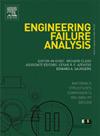船用Ti-6Al-4V薄板焊接结构冲击损伤及破坏机理研究
IF 5.7
2区 工程技术
Q1 ENGINEERING, MECHANICAL
引用次数: 0
摘要
随着轻量化的发展,钛合金材料已逐步应用于高速船舶或上层建筑,但低速碰撞下钛合金船体结构抗冲击性能的研究尚未得到有效开展。以GTAW制备的Ti-6Al-4V薄板对接焊接结构为研究对象,利用水平冲击试验平台对焊接结构焊缝位置进行了低速冲击试验,验证了低速冲击下Ti-6Al-4V焊缝的本构模型和失效准则。为保证样品的可靠性,制样过程中采用高纯氩气(前后气体流量分别为20、15l min,氧气小于50ppm)。优化后的焊接参数为电压20.4 V,电流140A,速度5 mm/s。焊接后进行表面试剂渗透检测和超声无损检测。对低速冲击后Ti-6Al-4V焊缝的SEM显微分析表明,冲击后Ti-6Al-4V焊缝的断裂方式为脆性和韧性混合断裂。通过双椭球热源和盲孔法的热-力耦合仿真计算,得到并验证了焊接接头中焊接残余应力的分布规律。此外,将焊接残余应力引入冲击仿真模型,量化残余应力对钛合金焊接结构抗冲击性能的影响。结果表明,焊接残余应力降低了结构的冲击接触刚度,加速了裂纹扩展,使结构的抗冲击性能降低了约10%。焊接后的残余应力显著降低了结构的抗冲击性。本文章由计算机程序翻译,如有差异,请以英文原文为准。
Study on impact damage and failure mechanism of marine Ti-6Al-4V thin plate welded structure
With the development of lightweight, titanium alloy materials have been gradually applied to high-speed ships or superstructure, but the research on impact resistance of titanium alloy hull structure under low-speed collision has not been effectively carried out. Taking the butt welded structure of Ti-6Al-4V thin plate prepared by GTAW as the research object, the low-speed impact test was carried out on the weld position of the welded structure by using the horizontal impact test platform, and the constitutive model and failure criterion of Ti-6Al-4V weld under low-speed impact were verified. In order to ensure the reliability of the sample, high-purity argon gas is used in the sample preparation process (the front and rear gas flows are 20 and 15 L min, respectively, and oxygen is less than 50 ppm). The optimized welding parameters are voltage 20.4 V, current 140A and speed 5 mm/s. After welding, the surface reagent penetrant testing and ultrasonic nondestructive testing are carried out. SEM microscopic analysis of Ti-6Al-4V weld after low-speed impact shows that the fracture mode of Ti-6Al-4V weld after impact is a mixed fracture of brittleness and toughness. Through the thermal–mechanical coupling simulation calculation of double ellipsoid heat source and blind hole method, the distribution law of welding residual stress in welded joint is obtained and verified. Furthermore, the welding residual stress is introduced into the impact simulation model to quantify the influence of residual stress on the impact resistance of titanium alloy welded structure. The results show that the welding residual stress reduces the impact contact stiffness of the structure, accelerates the crack propagation and reduces the impact resistance by about 10 %. The residual stress after welding significantly reduces the impact resistance of the structure.
求助全文
通过发布文献求助,成功后即可免费获取论文全文。
去求助
来源期刊

Engineering Failure Analysis
工程技术-材料科学:表征与测试
CiteScore
7.70
自引率
20.00%
发文量
956
审稿时长
47 days
期刊介绍:
Engineering Failure Analysis publishes research papers describing the analysis of engineering failures and related studies.
Papers relating to the structure, properties and behaviour of engineering materials are encouraged, particularly those which also involve the detailed application of materials parameters to problems in engineering structures, components and design. In addition to the area of materials engineering, the interacting fields of mechanical, manufacturing, aeronautical, civil, chemical, corrosion and design engineering are considered relevant. Activity should be directed at analysing engineering failures and carrying out research to help reduce the incidences of failures and to extend the operating horizons of engineering materials.
Emphasis is placed on the mechanical properties of materials and their behaviour when influenced by structure, process and environment. Metallic, polymeric, ceramic and natural materials are all included and the application of these materials to real engineering situations should be emphasised. The use of a case-study based approach is also encouraged.
Engineering Failure Analysis provides essential reference material and critical feedback into the design process thereby contributing to the prevention of engineering failures in the future. All submissions will be subject to peer review from leading experts in the field.
 求助内容:
求助内容: 应助结果提醒方式:
应助结果提醒方式:


